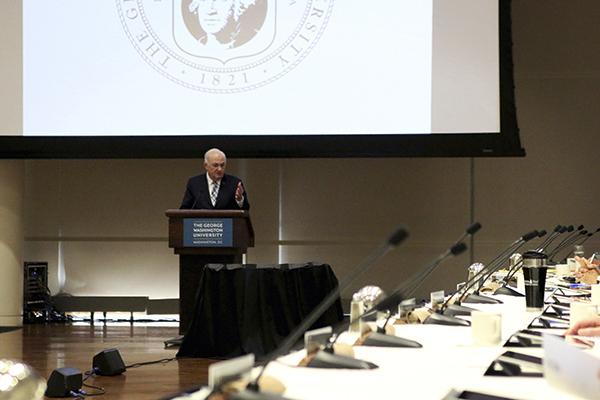GW will have $27 million more to give to students in financial aid next year.
The Board of Trustees approved roughly $182 million for undergraduate students’ financial aid Friday, an increase of about 6.5 percent from last year and part of the largest expansion in financial aid funds the University has signed off on in six years. The increase partially stems from the larger size of next fall’s freshmen class, after officials accepted 45 percent of all applicants.
More than $260 million for financial aid will be set aside for all students, an 11 percent increase from the pool of money available to students last year. Part of that increase comes from a 23 percent jump in graduate student aid, which grew to $78 million.
University spokeswoman Candace Smith said in an email that swelling aid pool was based on several criteria including anticipated enrollment growth, increases in tuition and “the amount available through philanthropy.”
“Most importantly, the increase stems from the University’s commitment to enhancing access and ensuring our financial aid packages remain competitive in the higher education marketplace,” Smith said.
The amount of aid money available to undergraduates dropped by $2 million in 2013, a decrease officials attributed to a smaller undergraduate class. Officials predict to gain an extra $56 million in tuition revenue for the upcoming year, according to the fiscal year 2016 operating budget that the Board of Trustees signed off on Friday.
The bump in tuition revenue could help GW with its current budget issues because the University is dependent on tuition for roughly 75 percent of revenue.
Tuition for incoming students will increase 3.4 percent in the fall, the first year it will be more than $50,000, but an amount that’s about in line with past increases. A portion of those funds will also go toward mental health resources on campus. As part of its overall focus on affordability, officials lock in tuition for returning students through the University’s fixed tuition policy.
Officials publicly revealed for the first time last fall that they place hundreds of students who cannot afford the cost of tuition on the waitlist each year, a decision that affects about 10 percent of applicants annually.
Sandy Baum, a financial aid expert and higher education professor at the Graduate School of Education and Human Development, said some universities may increase the aid amount in hopes the students will decide to come and pay the rest of the cost to attend.
“If we can give someone a $10,000 grant and get them to enroll, [and] if they didn’t enroll, we wouldn’t have the other $50,000,” she said.

She said colleges across the country have faced pressure to admit more students from low and middle-income families. Over the past five years, middle-class families at GW have had to pay more than double the amount high-income families do, even after receiving financial aid packages.
“If the size of the class goes up, even if they aid students at the same rate that they were before, the dollar amount of aid is going to go up,” she said.
Antoinette Flores, a policy analyst for the Center for American Progress who focuses on student debt and financial aid, said an extra scholarship could be the final push a student needs to choose GW over another university. As schools increasingly use smaller packages of merit aid to lure talented students, merit-based aid at GW has increased by more than a third since 2010.
“GW might be able to offer someone a $2,000 grant or merit aid scholarship, and it could encourage higher income students to attend that institution over another institution,” she said.
Officials predict that $12 million will be used for scholarships and money used for University fellowships for students for the next fiscal year, a $1 million decrease from last year, according to the operating budget approved by the Board of Trustees Friday.
Rick Ross, the co-founder of College Financing Group, a financial aid consulting firm, said schools like GW do their best to make sure their financial aid pool never dips below a certain monetary level so as many students as possible can receive aid without the institution losing money.
Experts said last year’s increase in financial aid would not hurt the University financially because it matched GW’s planned tuition increase.
He said officials have to strike a delicate balance when determining how much money to give out to students, including both merit and other kinds of aid.
“At every college they would ideally want every student to pay full tuition,” Ross said. “They don’t want to give away their money, so they’re going to try to see how much merit aid they need to get to attract this student without giving away too much.”
Jacqueline Thomsen contributed reporting.







